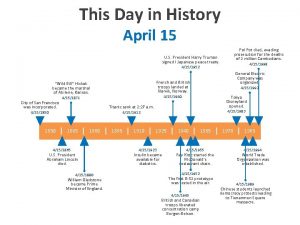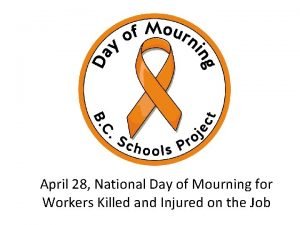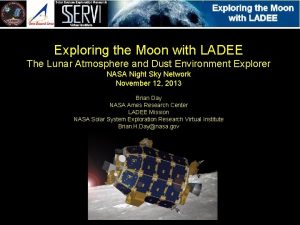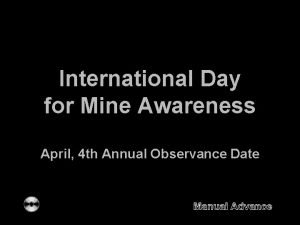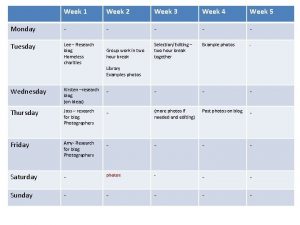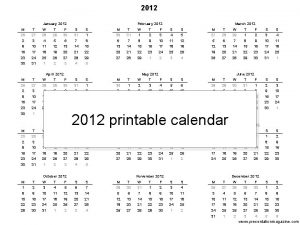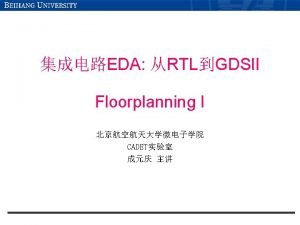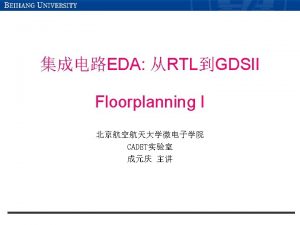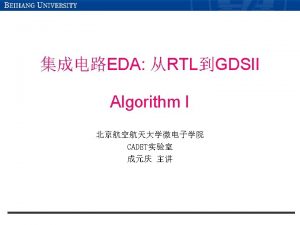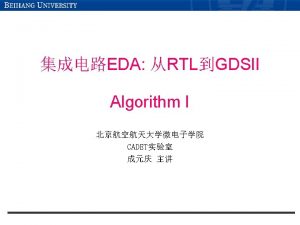Week 1 Lecture 2 April 11 2012 Department










































- Slides: 42

Week 1, Lecture 2 April 11, 2012 Department of RS and GISc Institute of Space Technology, Karachi INTRODUCTION TO GEOGRAPHICAL INFORMATION SCIENCE RSG 620

Introduction to GIS What is GIS? G? I? S? Studies Geographical Information System, Science,

What is Geography? Definition: Geography is the study of the world's environment and man's interaction within the environment. ” Geography has two parts: 1. PHYSICAL: The study of the earth's natural features, such as mountains, rivers, soil, vegetation, and weather 2. HUMAN: (Cultural) The study of human cultures and man made features. “All kinds of resources are used to study geography, but the most common are MAPS. ”

Why Geography is important? Why are we more interested in spatial data today than 100 years ago? Reference: Bolastad, 2008

How an object on Earth can be defined?

There are two ways of explaining any element/object on the Earth Location Information: Where is it? O O X South, Y West Attribute Information: What is it? Type ……. Species ……. Heights ……. Use ……. GIS can tell us Where and What

Why GIS is Important? What is Where? : Query information to find location Or Where is what? Obtain information from a location Impact of spatial information on our lives? Applied geography, in the form of maps and spatial information, has served discovery, planning, cooperation, and conflict for at least the past 3, 000 years (Bolstad)

GIS is about Geospatial Information Geography/Geospatial: Information about places on earth Not only Where and What but time is also important What is Where, When?

S in GIS? S as in System S as in Science Technology (for acquiring and managing GIS data) Concept behind the technology. Theoretical foundation on which GISystems are based S as in Studies Societal context (social, legal, and ethical issues related to GIS application)

Simpler Definitions A GIS helps us gather and use spatial data (Bolstad) A computer system which can hold and use data describing places on the earth's surface.

GIS. . . A GIS is not simply a computer system for making pretty maps. More importantly a GIS. . . • . . . is an analysis tool • . . . links spatial data with geographic information about a particular feature on a map • . . . can use the stored attributes to compute new information about map features

A more Comprehensive Definition A GIS is a computer-based system to aid in the collection, maintenance, storage, analysis, output, and distribution of spatial data and information.

Some other popular definitions of GIS A powerful set of tools for collecting, storing, retrieving, transforming and displaying spatial data from the real world. (Burrough, 1986) Any manual or computer based set of procedures used to store and manipulate geographically referenced data. (Aronoff 1989)

Some other popular definitions of GIS • A decision support system involving the integration of spatially referenced data in a problem solving environment. (Cowen 1988) • Systems that know how to deal with stuff in space. (Herrington 1998)

Conventional Ways to Store Data DATABASES • A Database comprises of tables having fields with specific data structure. • The tables are linked with each other through various common fields.

Conventional Ways to Store Data MAPS • Map can be defined as “A Facility for displaying interpretation of geographic information on a flat surface. ” • Location information describes the position of a particular geographic feature on earth's surface & provides the basis for representing spatial relationships between these features.

Databases Vs Maps Bad Searching Very good Searching What? if link together Bad Visual Interpretation Very Good Visual Interpretation

Basic GIS Functions

Basic GIS Functions Capture Collecting data using different data structures and technologies – GPS, RS, Digitizing, etc. Store Data stored in the form of databases, spatial files, drawings, images, etc. Query A GIS must provide utilities for finding specific features based on their location or attribute values Analyze A GIS must have the ability to answer questions regarding the interaction of spatial relationships between multiple datasets Display There must be tools for visualizing the spatial information in the form of maps Output Results of display should be able to be output in a variety of formats

GIS Functions Data Capturing

GIS Functions Storing Data v Tables

GIS Functions Spatial Query ØQuery: Select Florida county Taylor on map

GIS Functions Spatial Analysis

GIS Functions Display

GIS Functions Output

GIS Functions Output Soft Copy Hard Copy - Electronic map (visual digital map + multimedia) - Digital Atlas - Digital Layouts - Web Based Maps (Interactive Web Mapping) - Maps (Topographic, Statistical, 3 D, Contour etc) - Atlases - Reports (Write-ups etc) - Charts, Graphs

GIS Key Components 1. 2. 3. 4. 5. GIS hardware GIS software GIS data (maps, images, database, etc. ) People Methods Picture reference: http: //www. mapsofindia. com/images/gis-components. jpg

GIS Components Hardware is the computer system on which software operates

GIS Components Hardware Reference: Bolstad

GIS Components Software GIS software combines spatial mapping and analysis with database management GIS software provides the functions and tools to store, analyze, and display and disseminate spatial data and information Many public domain and commercially available software packages in the market ESRI (Environmental Systems Research Institute) line of products a good example (including Arc. GIS)

GIS Components Software Key components to GIS software: 1. An easy-to-use graphical user interface (GUI) 2. Tools for entering and manipulating geographic information 3. Tools that support geographic query, analysis and visualization 4. A database management system (DBMS)

Functions Commonly Provided by GIS Software Reference: Bolstad, 2008

GIS Components GIS Data Map + Database Digital maps (virtual representation of world) Map = Spatial representation of features Database = Feature attributes Data Sources Available through various sources like profit and nonprofit organizations, academic institutions, government agencies

GIS Components GIS Data Flood Zones Wetlands Landcover Electric Lines Gas Pipe Lines Soils Land Ownership Transportation Surface Waters Boundaries Geodetic Control Elevation Satellite Imagery GIS Combines Data from Many Sources

GIS Component Data Format

GIS Components GIS Data

GIS Components People • GIS personnel may include – GIS technologist to design and maintain the system • General programmers • GIS developers – GIS Users • GIS Managers • Data providers • GIS specialist/analyst • General users and Public users

GIS Components Methods Analysis to be performed on data To answer the question needs to be resolved How to › › › › Retrieve Input into the system Stored Managed Transformed Analyzed Presented as output

Other GIS Components Supporting institution Protocol for use

Some Advantages of GIS Automation of procedures involving geographic data (map making, calculation of area, slope, etc. , and planning and management activities) Integration of data from different independent domains Visual Interpretation of spatial data depending on various criteria Perform Spatial Queries and complex Spatial Modeling (what if scenarios) More

GIS Benefits • Geo-spatial data are better maintained in a standard format • Revision and updating are easier • Easier to search, analyze and represent • More value added as well as thematic product • Geo-spatial data can be shared and exchanged easily • Working productivity is improved and more efficient • Time and money are saved • Better decisions in short span of time

THANK YOU
 01:640:244 lecture notes - lecture 15: plat, idah, farad
01:640:244 lecture notes - lecture 15: plat, idah, farad Week by week plans for documenting children's development
Week by week plans for documenting children's development Guten morgen freitag 1 april
Guten morgen freitag 1 april April christian
April christian This day in history april 15
This day in history april 15 National sovereignty and childrens day
National sovereignty and childrens day April 28 day of mourning
April 28 day of mourning Calendar april 2009
Calendar april 2009 April rain song by langston hughes
April rain song by langston hughes Passover is in late march or early april
Passover is in late march or early april April ford incentives
April ford incentives April savoy allstate
April savoy allstate April 6 1992
April 6 1992 20.april 1889
20.april 1889 April 1958
April 1958 27 april 2001
27 april 2001 April ericsson
April ericsson April reprogle
April reprogle April romagnano
April romagnano Astronomy picture of the day 17 april 2001
Astronomy picture of the day 17 april 2001 April piscids
April piscids Leonardo de vinci was born on april 15
Leonardo de vinci was born on april 15 April decker
April decker La bamba gary soto
La bamba gary soto Paula hurlock birthday
Paula hurlock birthday 30 days has september
30 days has september April bjornsen
April bjornsen April 8th in history
April 8th in history Amsterdam 27 april
Amsterdam 27 april March april may season
March april may season History of april fools day in islam
History of april fools day in islam April dye
April dye Apod nasa gov calendar 1982
Apod nasa gov calendar 1982 8 day week
8 day week April 23, 1564
April 23, 1564 International day april 4
International day april 4 Falske computer timeshare company
Falske computer timeshare company 30 tage hat september april juni und november
30 tage hat september april juni und november 3 april 2008
3 april 2008 What is april dedicated to
What is april dedicated to April 23, 1564
April 23, 1564 27 april 2003
27 april 2003 Halloween is nearly here kenn nesbitt
Halloween is nearly here kenn nesbitt




